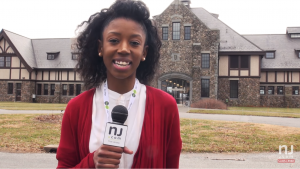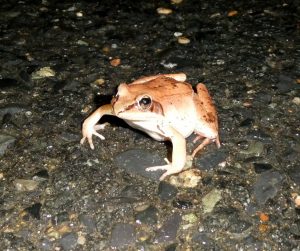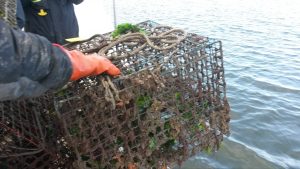Falcon Comeback Continues in Union County
By Jasmine Lee, CWF Education Assistant

Spring has sprung, and peregrine falcon eggs have hatched! Viewers of our Union County Falcon Cam have enjoyed an exciting few days with the last of the four eyasses (baby falcons) emerging yesterday.
The adult female falcon 91/BA (“Cadence”) originally hails from Rochester, New York. She staked her claim on this nest last year and laid eggs very late last season, but the eyasses did not survive. This year, 91/BA got a timely start, with her first egg being laid on March 29, 2018. Incubation of her clutch of four eggs began on April 3.
While peregrine falcon feathers provide excellent insulation, it can be difficult for body heat to get past the feathers and to the eggs. An adaptation for this is the brood patch on the male’s and female’s chest. This patch has a high concentration of blood vessels close to the surface of their skin to allow for easier and better body heat transfer to the eggs.
After about 32 days, it is time for hatching to begin. The chicks begin by using a small “egg tooth” to peck a hole through the egg shell: this is called the external pip. After breaking the membrane, the chick can breathe some fresh air, and vigorously start the final process of hatching.
Around 8 AM on Saturday, May 5, the first eyas at Union County emerged! As we watch over the next few weeks, we will see a lot of activity in the nest as the parents work hard to feed the hungry chicks. The eyasses are completely dependent upon the adults and will eat an incredible amount, but they typically double in size in just six days! They will continue to be under constant care until they are ready to fly in approximately seven weeks.
An Inspiring Recovery

In 2017 there were 34 nesting pairs of peregrine falcons were reported in all of New Jersey. Around two-thirds are known to have made their homes in buildings like the County Courthouse.
Until recent decades, the peregrine falcon population was in steep decline along with other birds of prey due to habitat loss and the pesticide DDT. By 1964, peregrine falcons had disappeared completely from New Jersey and all other states east of the Mississippi River.
Peregrine falcons were one of the first birds to be the focus of conservation efforts after the 1960’s.
In the 1980’s an intensive re-introduction effort began in the tri-state region, with biologists from the Endangered and Nongame Species Program and CWF leading the way in New Jersey. Since 2000 the New Jersey population has stabilized at approximately two dozen nesting pairs annually.
Livestreaming in Union County
2018 marks CWF’s second year partnering with Union County, providing a live stream of the action in and around the peregrine falcon nest located on the roof of the County Courthouse in midtown Elizabeth. CWF is proud to share the excitement in livestreaming the UCNJ Falcon Cam on our website and to use the webcam in our Union County school presentations, generously funded by Phillips 66.
Go to our website today to watch our new feathered friends as they continue to interact, and to learn more about the Peregrine Falcon. For more information about peregrine falcons, you can also visit the New Jersey Department of Environmental Protection, Division of Fish & Wildlife.

 The WNET-PBS Nature program Peril & Promise’s second live interview with Conserve Wildlife Foundation marked the Great Backyard Bird Count by focusing on the inspiring recovery of the bald eagle. This
The WNET-PBS Nature program Peril & Promise’s second live interview with Conserve Wildlife Foundation marked the Great Backyard Bird Count by focusing on the inspiring recovery of the bald eagle. This 





 These amphibian programs cannot move forward without the dedication of CWF volunteers. Over 100 volunteers have been involved with the Amphibian Crossing Project, and a dozen more dedicated at least a day a week for months to monitor Waterloo Road amphibian mortality. With the success of CAMP in mind, this first year of Kauffeld’s Calling Frogs promises to be full of new frog population discoveries.
These amphibian programs cannot move forward without the dedication of CWF volunteers. Over 100 volunteers have been involved with the Amphibian Crossing Project, and a dozen more dedicated at least a day a week for months to monitor Waterloo Road amphibian mortality. With the success of CAMP in mind, this first year of Kauffeld’s Calling Frogs promises to be full of new frog population discoveries.













